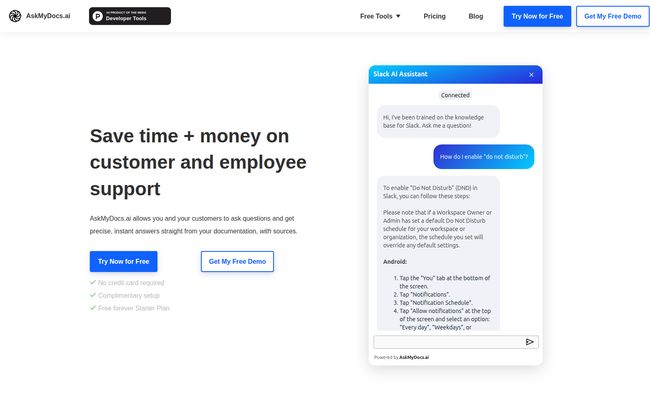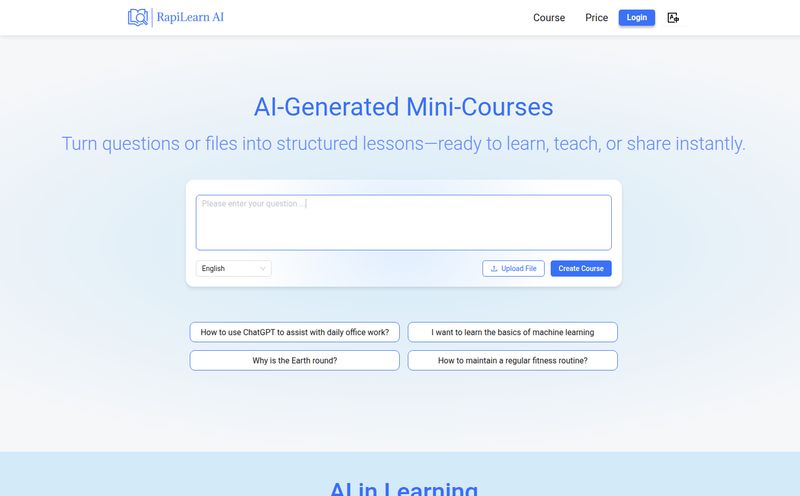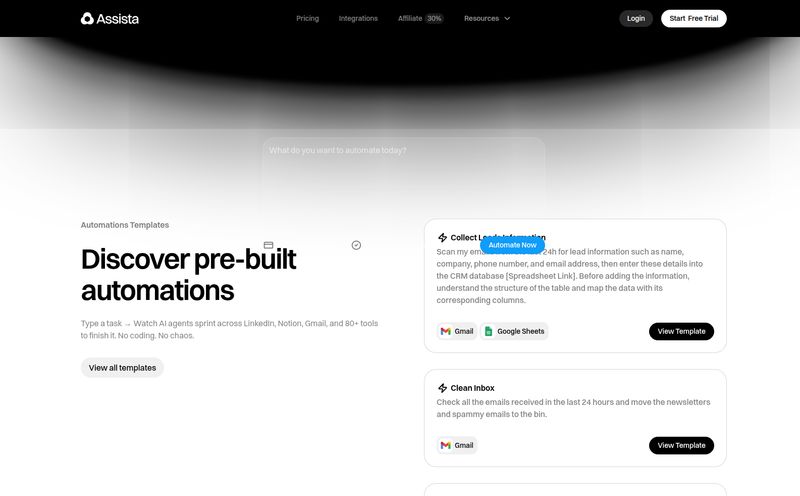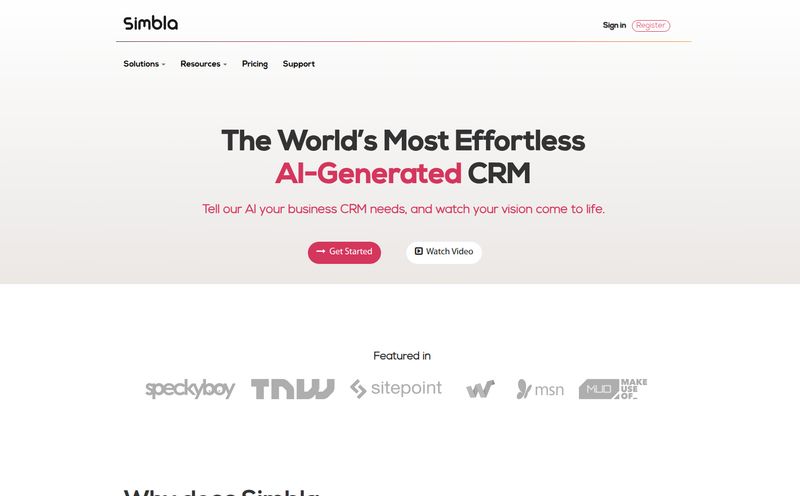We’ve all been there. You have a question. You know the answer is lurking somewhere in the company’s massive library of Google Docs, Confluence pages, or that Zendesk knowledge base that hasn't been touched since 2019. So you start digging. Ten minutes later, you're lost in a sea of outdated information and conflicting reports. Frustrated, you give up and just tap your senior dev on the shoulder (or, more likely, ping them on Slack), interrupting their flow for a question that’s been answered a dozen times before.
This is the silent productivity killer in so many organizations. It's the documentation graveyard, a place where good information goes to die. As someone who's spent years optimizing workflows and staring at traffic analytics, I can tell you that internal friction is just as costly as poor external SEO. It's a constant, low-grade headache that drains time and morale.
So, when a tool like AskMyDocs.ai comes along, promising to solve this exact problem, my ears perk up. It claims to be an AI assistant that turns your documentation into a genuinely useful, interactive resource. But does it live up to the hype? I decided to take a closer look.
So, What on Earth is AskMyDocs.ai?
Let's cut through the marketing jargon. At its core, AskMyDocs.ai is like a super-smart librarian for your company's brain. You feed it all your existing documentation—your PDFs, your support articles, your Gitbook, even your entire website—and it creates a powerful, searchable AI assistant. Instead of your team or your customers having to manually search for information, they can just ask a question in plain English.
The magic isn't just that it gives an answer; it's that it gives a precise answer and, crucially, cites its sources. It points directly to the document or page where it found the information. This single feature is a massive deal, because it builds trust and allows for verification. It’s the difference between a confident answer and a potential AI hallucination that sends you down the wrong path.

Visit AskMyDocs.ai
The All-Too-Familiar Nightmare of Buried Knowledge
I remember at a previous agency, we had a shared drive folder we jokingly called 'The Abyss'. It was a dumping ground for every project brief, process doc, and client report from the last decade. The company's entire history was in there! But finding anything specific? Forget it. It was faster to just re-do the work or ask someone who’d been there for 15 years and kept it all in their head.
This isn’t a unique story. It's the default state for most growing companies. The result is a ton of wasted time. A McKinsey report a while back found that employees spend nearly 20% of their workweek just looking for internal information. That’s an entire day, every single week, spent just… looking. It's madness.
This pain is felt everywhere:
- Customer Support: Answering the same Top 10 questions over and over again via email and chat.
- Employee Onboarding: New hires feeling lost, constantly asking basic questions about benefits, processes, or software.
- Sales Teams: Scrambling to find the latest product specs or case studies before a call.
- Developers: Trying to find that one specific API guide in a sea of outdated internal wikis.
This is the problem AskMyDocs.ai is built to solve. It’s not just a fancy gadget; it's a direct assault on inefficiency.
How AskMyDocs.ai Actually Works (The Good Parts)
So how does it pull this off? It comes down to a few key features that are surprisingly well-thought-out. It’s not just a generic AI wrapper; the integrations show they understand the real-world workflows of modern teams.
Integrations That Just Make Sense
This is where the platform really shines for me. It doesn’t force you to migrate all your documetation to a new, proprietary system. Instead, it meets you where you are. You can connect it directly to the tools you already use:
- Slack: This is huge for internal teams. You can set up the AskMyDocs.ai bot in a channel, and anyone can ask questions directly within Slack. No context switching, no new app to learn. It just works where your team works.
- Zendesk: For customer support teams, this is a game-changer. It can plug into your Zendesk knowledge base to help deflect tickets by providing customers with instant answers.
- Gitbook: A popular choice for developer documentation and product guides. Point AskMyDocs.ai at your Gitbook, and suddenly your complex technical docs are easily searchable.
- PDF & Sitemap: This is the catch-all. Got a bunch of user manuals as PDFs? Upload them. Want it to learn from your entire website or blog? Just give it the sitemap. It’s incredibly flexible.
Answers You Can Actually Trust
I mentioned this before, but it's worth repeating. The biggest hurdle for AI adoption inside a business is trust. If an AI gives you a wrong answer about a critical business process, it’s worse than no answer at all. By providing the source for every answer, AskMyDocs.ai gives you a verification trail. It's not a black box; it's a research assistant. It shows its work. This is, in my opinion, non-negotiable for any serious business tool in this space.
A Handy Little Resource Savings Calculator
On their site, they have a simple slider to estimate how much time your team spends answering questions each month. It’s a small thing, but it’s a smart way to frame the ROI. It forces you to put a number on the pain point, turning a vague frustration into a tangible business cost. Clever.
Let's Talk Money: The AskMyDocs.ai Pricing Tiers
Alright, let's get down to brass tacks. Is this thing affordable? The pricing structure is pretty standard for a SaaS product, with a few pleasant surprises. I've laid it out in a simple table so you can see what you get at each level.
| Plan | Price | Key Features |
|---|---|---|
| Starter | Free | 50 questions/mo, 1 datastore, 2 users, 1 day of analytics. |
| Builder | $49 /month | 1,000 questions/mo, 3 datastores, 5 users, 30 days of analytics. |
| Innovater | $99 /month | 5,000 questions/mo, 5 datastores, 20 users, 60 days of analytics. |
| Custom | Custom | Custom limits, premium support, and access to custom features. |
My take? The Free plan is genuinely useful. 50 questions is enough to properly test it out with a small team and a single knowledge base to see if it works for you. There's no credit card required, which I always appreciate. It shows confidence in the product.
The Builder plan at $49/month feels like the sweet spot for most small-to-medium businesses. 1,000 questions is a decent amount, and it's an affordable price point for the amount of time it could save.
The Innovator and Custom plans are for larger teams or companies with more complex needs. The main thing to know is that truly custom features are reserved for that top-tier Custom plan, which is a pretty standard industry practice.
The Good, The Bad, and The AI
No tool is perfect. So here's my honest breakdown of the pros and cons, based on what I've seen.
The Good Stuff is Pretty Obvious. The time and money savings are real. Automating answers for repetitive questions frees up your most valuable people to do more important work. The ease of integration is a massive plus; you can get it running quickly without a major IT project. And again, that free starter plan makes it a no-brainer to at least try.
Now, for the Not-So-Good Stuff. Let's be realistic. The limits on the free plan are, well, limiting. 50 questions and 1 day of analytics data won't run your whole support department, but that’s not what it’s for. It’s a trial. The biggest potential downside for some companies will be that the really bespoke, custom features are locked away in the enterprise-level plan. If you have a very specific, niche requirement, you’ll likely have to pay for the top tier. But for 90% of use cases, the off-the-shelf plans seem more than adequate.
Who is This Tool Actually For?
I see a few groups getting a ton of value out of this immediately:
- Startups and SMBs: Teams that are growing fast but don't have a dedicated person to manage internal knowledge. This tool can be that person.
- Customer Support Teams: Any support leader looking to improve their self-service offerings and reduce ticket volume should be looking at tools like this. It can power a public-facing FAQ bot on your website.
- HR and Operations: Perfect for centralizing all those HR policies, benefits guides, and onboarding documents. Imagine a new hire being able to ask, "How do I submit an expense report?" and getting an instant, correct answer with a link to the form.
- Product & Engineering Teams: To make their technical documentation actually usable and accessible for the rest of the company.
My Final Verdict on AskMyDocs.ai
So, what's the final word? In an increasingly crowded market of AI tools, AskMyDocs.ai stands out by doing one thing and doing it well. It focuses on a clear, painful, and expensive business problem: inaccessible knowledge. It doesn't try to be everything to everyone. It’s a focused solution that connects your existing information silos with the people who need that information, using a simple, conversational interface.
It's not a magic wand, you still need to have decent documentation to begin with. Garbage in, garbage out, as they say. But if you have the knowledge already written down somewhere, this tool acts as a brilliant translation layer. It gives your documentation a voice.
My advice? If the problem I described at the beginning of this article sounds even remotely familiar, go try the free plan. Hook it up to one of your knowledge bases and let your team have at it for a week. I think you'll be pleasantly surprised.
Frequently Asked Questions (FAQ)
How does AskMyDocs.ai ensure its answers are accurate?
The platform's biggest strength is that it doesn't just give an answer, it cites the specific source from your uploaded documentation. This allows you to verify the information and builds trust in the system. It's answering based only on the material you provide.
Is AskMyDocs.ai difficult to set up?
No, it's designed to be straightforward. The integrations with platforms like Slack, Zendesk, and Gitbook are meant to be simple connections. For PDFs or sitemaps, it's mostly a matter of pointing the tool to the right source. You don't need a dedicated developer to get it running.
Can I customize the look and feel of the chatbot?
Yes, the embedded chatbot that you can place on your website is customizable. This allows you to match its appearance to your brand's style guide for a consistent user experience.
What happens if I go over my monthly question limit?
Typically with SaaS models like this, if you consistently exceed your plan's limits, you'll be prompted to upgrade to the next tier. The free plan is designed for trial and very light use, while the paid plans offer much higher volumes.
Does it only work with PDF files?
Not at all. While it has a powerful PDF integration, it also connects directly with platforms like Zendesk, Gitbook, Slack, and can crawl an entire website via its sitemap. This flexibility is one of its key advantages.
Reference and Sources
- AskMyDocs.ai Official Website
- AskMyDocs.ai Pricing Page
- McKinsey Global Institute - "The Social Economy" Report



